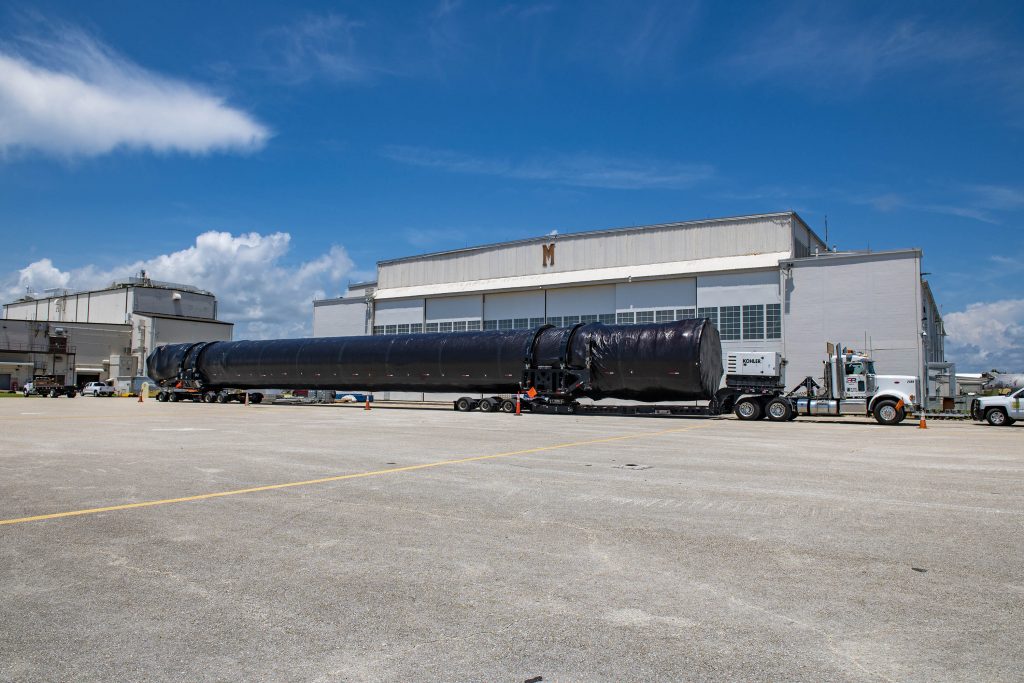The Falcon 9 rocket for SpaceX's next NASA astronaut flight arrives at launch site (photo)

The rocket that will launch SpaceX's first operational crewed flight for NASA has arrived at its Florida launch site.
The first stage of the Falcon 9 rocket for the Crew-1 mission, which is scheduled to launch from NASA's Kennedy Space Center (KSC) on Aug. 30, reached the Sunshine State on Tuesday (July 14), agency officials said. The booster made the long trek from SpaceX's facility in McGregor, Texas, wrapped in a protective black shroud.
The Falcon 9 will now undergo prelaunch processing at SpaceX's facility at Cape Canaveral Air Force Station, NASA officials said. Cape Canaveral is next door to KSC.
Related: SpaceX is already prepping for Crew-1 mission
The Crew-1 launch will send NASA astronauts Victor Glover, Michael Hopkins and Shannon Walker and Japan's Soichi Noguchi to the International Space Station (ISS) aboard a SpaceX Crew Dragon capsule. The quartet will stay aboard the orbiting lab for about six months.
Crew-1 will be the first full-fledged mission of at least six that SpaceX will fly under a $2.6 billion contract the company signed with NASA in 2014. But it won't be the first crewed flight for Elon Musk's company.
That distinction goes to Demo-2, a test mission that launched NASA astronauts Bob Behnken and Doug Hurley to the ISS in late May. Demo-2 was the first crewed orbital launch from the U.S. since the final flight of NASA's space shuttle program way back in July 2011. Since then, all astronauts had flown to and from the ISS aboard Russian Soyuz spacecraft.
Breaking space news, the latest updates on rocket launches, skywatching events and more!
Behnken and Hurley are scheduled to return to Earth in the next few weeks. If Demo-2 continues to go well, SpaceX will be clear to launch Crew-1.
Though NASA recently approved the use of pre-flown SpaceX hardware on crewed ISS missions, the Crew Dragon and Falcon 9 that will fly Crew-1 are both brand-new.
Boeing also signed a contract with NASA's Commercial Crew Program in 2014, a $4.2 billion deal that the aerospace giant will fulfill using a capsule called CST-100 Starliner. Starliner isn't quite ready to start flying astronauts, however; the capsule must first ace an uncrewed demonstration flight to the ISS.
This attempt, which is expected to launch later this year, will be Starliner's second try at an uncrewed ISS mission. During the first attempt, which launched in December 2019, Starliner suffered a glitch with its onboard timer and got stuck in an orbit too low to rendezvous with the ISS.
Mike Wall is the author of "Out There" (Grand Central Publishing, 2018; illustrated by Karl Tate), a book about the search for alien life. Follow him on Twitter @michaeldwall. Follow us on Twitter @Spacedotcom or Facebook.

Michael Wall is a Senior Space Writer with Space.com and joined the team in 2010. He primarily covers exoplanets, spaceflight and military space, but has been known to dabble in the space art beat. His book about the search for alien life, "Out There," was published on Nov. 13, 2018. Before becoming a science writer, Michael worked as a herpetologist and wildlife biologist. He has a Ph.D. in evolutionary biology from the University of Sydney, Australia, a bachelor's degree from the University of Arizona, and a graduate certificate in science writing from the University of California, Santa Cruz. To find out what his latest project is, you can follow Michael on Twitter.
